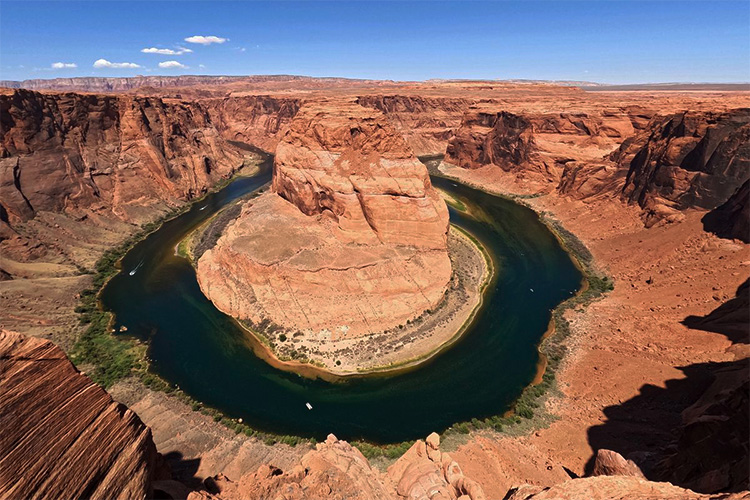
An aerial view of the drying Colorado River in the Glen Canyon National Recreation Area, Arizona. photo by Brittany Peterson
A decades-long drought has affected the Colorado River, and states surrounding the historic waterway are suffering.
The Colorado River spans 1,450 miles across the southwestern U.S., flowing through seven states: Wyoming, Colorado, Utah, New Mexico, Nevada, Arizona, and California. For these states, it is a crucial water and energy supplier. The river starts in Rocky Mountain National Park in Colorado and flows southwest into the Gulf of California and the Pacific.
The Colorado River has a rich history as it has always been important for the Southwest. Not only is it one of the nation’s most vital water sources today, but for centuries it has also supplied numerous groups in the area. For 12,000 years, the Colorado River basin was the lifeblood of Indigenous tribes in the West. Later, it supported settlers, Mormons, and many other groups until cities and states became more modern. However, as stated by the Washington Post in their article, in the 1900s, the states surrounding the river became more dependent on the water, especially as California’s population grew. With a growing fear that California would try to get priority rights, in 1922, The Colorado River Compact split the river into two basins. The Upper Basin includes Colorado, Utah, Wyoming, and New Mexico, while the Lower Basin includes Arizona, Nevada, and California. The compact gave exclusive rights to 7.5 million acre-feet (a unit of volume) of water to the lower basins, 4.4 million to California, 2.8 million to Arizona, and 300,000 to Nevada. A total of 17.5 million acre-feet goes to U.S. states and Mexico. The river is critical for as many as 35 million people who rely on it for drinking and irrigation water.
Dams were built along the river to support the basins with drinking water and hydroelectricity. The first dam on the Colorado River was the Laguna Diversion Dam on the Arizona and Colorado border, which only diverts the flow of water. However, as hydroelectricity began to grow as an energy source and account for over 25% of energy production in America, the Hoover Dam, the first hydroelectric dam on the Colorado River, was built in 1937. It began construction in 1931, and not only would it become a major generator in the years to follow, but would also support 20,000 Americans with jobs during the Great Depression. According to The Bureau of Reclamation, the Hoover Dam today generates 4 billion kilowatt-hours for the lower basin of the Colorado River, which provides electricity to 1.3 million people. It is the biggest dam on the Colorado River and one of the essential dams that generate electricity and helps control flooding on the Colorado River. The Hoover Dam also created Lake Mead, a large reservoir in Nevada that supports major cities with drinking and irrigation water.
However, the Washington Post has stated that due to climate change taking its toll on the Earth, the river has been experiencing a 23-year-long drought. The last three years have been breaking records as the river continues to dry up. A mix of climate change and overconsumption has caused the water levels in the river to decrease rapidly, and it is now the driest it has been in over 1,200 years. The drought has also affected the reservoirs derived from the Colorado River, such as Lake Powell in Arizona and Lake Mead in Nevada. Information from The Washington Post said that the Federal Government declared a first-time water shortage for Lake Mead in August of 2022, which, starting in 2023, limits what Nevada can withdraw from the reservoir. In 1999, the year the drought began, Lake Powell and Lake Mead combined held 47.6 million acre-feet of water and were about 92% full. This year, they only hold 12.9 million acre-feet of water and are 25% full.
A common misconception about climate change is that with more snow and rainfall, global warming becomes less of an issue. In recent years, citizens in the basins have hoped for more snowfall to fill the rivers, but it doesn’t have a major impact. While the Rocky Mountains have seen about 90% of the usual snowfall in past years, the runoff has stayed below 60%, even once hitting a mere 29%. As the soil and plants in the mountains also become dehydrated due to hotter temperatures, they need to absorb more runoff, resulting in minimal amounts ending up in the Colorado River. Despite these issues, Americans continue to over consume resources and run the vital river dry.
Another major issue surrounding the Colorado River crisis is how California will deal with the water shortages. A negotiation made by President Joe Biden asking the states relying on the river to cut usage by 2-4 million acre-feet has been accepted by six of the seven states involved. California was the only one that refused to sign, instead offering a different deal that would lead states to cut their usages at different times and by different amounts. California intends to cut its usage down by only 400,000 acre-feet per year for three years. This plan, while positive for California, would leave a scarce water supply for Arizona, limiting them to only 600,000 acre-feet of water from the river, instead of the 2.8 million they were promised. The tensions around the issue have continued to rise. If California refuses to sign, the unequal distribution of water to neighboring states will cause enormous problems for their inhabitants.
For now, the plan to address the issue is to cut water usage in each state by encouraging lower consumption for homes, workers, and citizens. Americans across the country can also help by lowering their fossil fuel and carbon footprints, which would help reduce the drastic climate changes that have become the primary cause of the harmful droughts across the Colorado River.